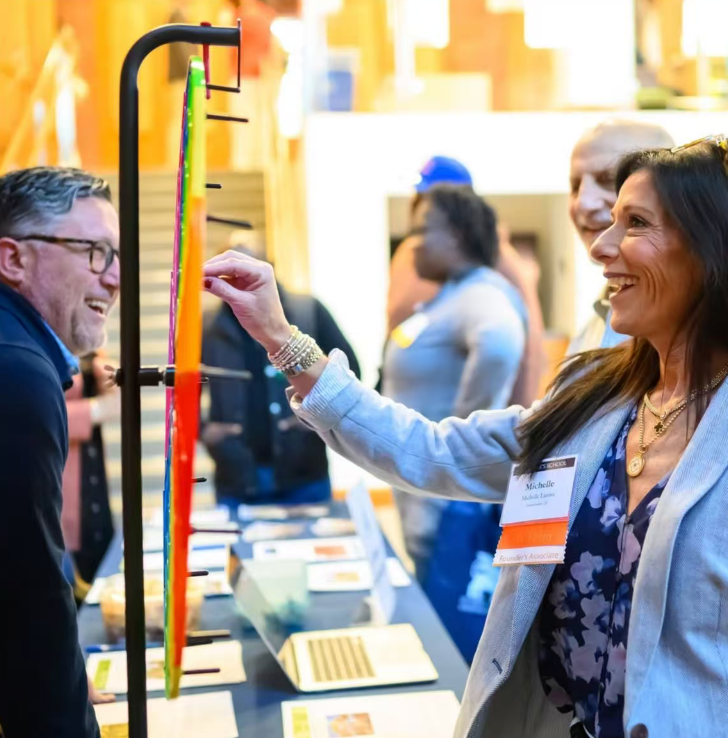by Joanna Cheng’29
From October 9–11, our campus buzzed with the excitement of Family Weekend, a tradition that brought together students, families, and faculty to celebrate the spirit of our school. We are all deeply grateful to our devoted teachers, staff, students, especially our exceptional Advancement Ambassadors, whose volunteer efforts were indispensable (from bringing our school spirit to life as lion mascots to ensuring every behind-the-scenes detail was set up). Whether you joined us in person or followed along from afar, here’s a recap of the memorable events that weekend.
Thursday
Family Weekend kicked off with the International Family Luncheon in the Faculty Room. Over lively conversation, our international families connected with one another and with faculty members, celebrating the diversity that strengthens our community. It was a warm reminder of how St. Mark’s brings the world together under one roof.
Friday
The day began with registration in the Parent Lounge, where families enjoyed coffee and pastries. The schedule was packed with opportunities to engage with every aspect of school life:
The Family Assembly in the Putnam Family Arts Center showcased the talents of our students, from speeches by student leaders to a performance by the Jazz Band.
Families then attended sessions with the Deans of Faculty, Students, and Academics, exploring topics like academic support, global opportunities, and student well-being. Parents were invited not only to understand but to contribute to the future of St. Mark’s.
Conferences with advisors and athletic practices followed. Families that met with advisors discussed their students’ progress, while athletes headed to practices in preparation for Saturday’s games.
Near the end, the Family Chapel service at Belmont Chapel offered a peaceful moment for prayer and reflection, allowing families to experience the traditions that connect our community.
The evening concluded with form-specific receptions and remarks from Head of School Dr. Hills and Parents’ Association Co-Chairs.
These activities highlighted our community, connection, and celebration.
Saturday
Saturday, one of the most anticipated days, offered a window into the academic life of St. Mark’s. Parents attended mini class sessions, stepping into their children’s shoes and experiencing firsthand the dynamic teaching and learning in our classrooms. These sessions not only allowed parents to understand St. Mark’s but also highlighted the dedication of our faculty and the curiosity of our students.
The weekend’s athletic achievements were nothing short of spectacular. Our teams delivered outstanding performances, skill, teamwork, and Lion pride:
JV volleyball (3–0 win over Milton)
Varsity volleyball (3–0 win over St. George’s)
Varsity field hockey (5–2 win over St. George’s)
JV field hockey (4–0 win over St. George’s. Still undefeated this season!)
JV girls’ soccer (4–0 win over St. George’s)
Varsity girls’ soccer (1–1 tie with St. George’s)
Varsity football (35–14 win over Governor’s. Varsity football’s win yesterday marks the best start for the Lions (4–0) since 1975!)
Varsity girls’ cross country (22–34 win over Brooks)
Varsity boys’ cross country (17–40 win over Brooks)
JV boys’ cross country (19–36 win over Brooks)
Beyond parents, students were thrilled to enjoy a four-day weekend. While some went home for a restful break, others hopped on Weekend Activity trips: exploring Harvard Square and the Boston Museum of Fine Arts, visiting the Topsfield Fair, and walking the Freedom Trail. For those who stayed on campus, St. Mark’s offered activities to relax, recharge, and connect with friends.
Family Weekend may be over, but the connections and memories made will carry into the year ahead. Thank you to everyone who contributed to this celebration of the St. Mark’s community. As we move forward, let’s carry this spirit of collaboration and pride with us.
Go Lions!









